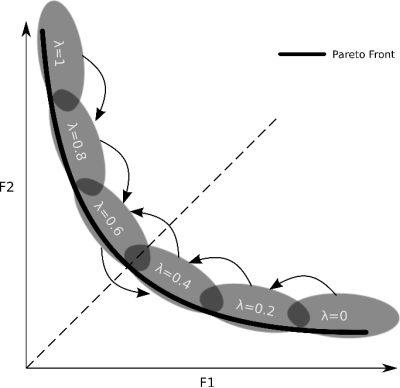We are excited because our work «Pareto-based multi-colony multi-objective ant colony optimization algorithms: an island model proposal» has been published in Soft Computing Journal this month, and is now on-line at http://link.springer.com/article/10.1007%2Fs00500-013-0993-y
Yes, the title is a representation of how long the work is :D
The abstract is:
Multi-objective algorithms are aimed to obtain a set of solutions, called Pareto set, covering the whole Pareto front, i.e. the representation of the optimal set of solutions. To this end, the algorithms should yield a wide amount of near-optimal solutions with a good diversity or spread along this front. This work presents a study on different coarse-grained distribution schemes dealing with Multi-Objective Ant Colony Optimization Algorithms (MOACOs). Two of them are a variation of independent multi-colony structures, respectively having a fixed number of ants in every subset or distributing the whole amount of ants into small sub-colonies. We introduce in this paper a third method: an island-based model where the colonies communicate by migrating ants, following a neighbourhood topology which fits to the search space. All the methods are aimed to cover the whole PF, thus each sub-colony or island tries to search for solutions in a limited area, complemented by the rest of colonies, in order to obtain a more diverse high-quality set of solutions. The models have been tested by implementing them considering three different MOACOs: two well-known and CHAC, an algorithm previously proposed by the authors. Three different instances of the bi-Criteria travelling salesman problem have been considered. The experiments have been performed in a parallel environment (inside a cluster platform), in order to get a time improvement. Moreover, the system scaling factor with respect to the number of processors will be also analysed. The results show that the proposed Pareto-island model and its novel neighbourhood topology performs better than the other models, yielding a more diverse and more optimized set of solutions. Moreover, from the algorithmic point of view, the proposed algorithm, named CHAC, yields the best results on average.
The scheme of the proposed model can be seen in the next figure:
Enjoy (and CITE) it! :D

Pingback: Pareto-based Island Model presented at GECCO 2013 | GeNeura Team
Pingback: Pareto-based Island Model presented at GECCO 2013 | ANYSELF
I’m impressed, I have to admit. Rarely do I encounter a blog that’s both equally educative and amusing,
and without a doubt, you’ve hit the nail on the head. The problem is something that too few people are speaking intelligently about. Now i’m very happy
that I came across this in my hunt for something relating to this.